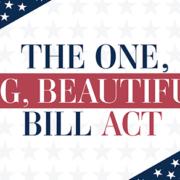President Trump signs his One, Big, Beautiful Bill Act into law
On July 4, President Trump signed into law the far-reaching legislation known as the One, Big, Beautiful Bill Act (OBBBA). As promised, the tax portion of the 870-page bill extends many of the provisions of the Tax Cuts and Jobs Act (TCJA), the sweeping tax legislation enacted during the first Trump administration. It also incorporates several of President Trump’s campaign pledges, although many on a temporary basis, and pulls back many clean-energy-related tax breaks.
While the OBBBA makes permanent numerous tax breaks, it also eliminates several others, including some that had been scheduled to resume after 2025. Here’s a rundown of some of the key changes affecting individual and business taxpayers. Except where noted, these changes are effective for tax years beginning in 2025.
Key changes affecting individuals
- Makes permanent the TCJA’s individual tax rates of 10%, 12%, 22%, 24%, 32%, 35% and 37%
- Makes permanent the near doubling of the standard deduction. For 2025, the standard deduction increases to $15,750 for single filers, $23,625 for heads of households and $31,500 for joint filers, with annual inflation adjustments going forward
- Makes permanent the elimination of personal exemptions
- Permanently increases the child tax credit to $2,200, with annual inflation adjustments going forward
- Temporarily increases the limit on the deduction for state and local taxes (the SALT cap) to $40,000, with a 1% increase each year through 2029, after which the $10,000 limit will return
- Permanently reduces the mortgage debt limit for the home mortgage interest deduction to $750,000 ($375,000 for separate filers) but includes mortgage insurance premiums as deductible interest
- Permanently eliminates the deduction for interest on home equity debt
- Permanently limits the personal casualty deduction for losses resulting from federally declared disasters and certain state declared disasters
- Permanently eliminates miscellaneous itemized deductions except for unreimbursed educator expenses
- Permanently eliminates the moving expense deduction (with an exception for members of the military and their families in certain circumstances)
- Expands the allowable expenses that can be paid with tax-free Section 529 plan distributions
- Makes permanent the TCJA’s increased individual alternative minimum tax (AMT) exemption amounts
- Permanently increases the federal gift and estate tax exemption amount to $15 million for individuals and $30 million for married couples beginning in 2026, with annual inflation adjustments going forward
- For 2025–2028, creates an above-the-line deduction (meaning it’s available regardless of whether a taxpayer itemizes deductions) of up to $25,000 for tip income in certain industries, with income-based phaseouts (payroll taxes still apply)
- For 2025–2028, creates an above-the-line deduction of up to $12,500 for single filers or $25,000 for joint filers for qualified overtime pay, with income-based phaseouts (payroll taxes still apply)
- For 2025–2028, creates an above-the-line deduction of up to $10,000 for qualified passenger vehicle loan interest on the purchase of certain American-made vehicles, with income-based phaseouts
- For 2025–2028, creates a bonus deduction of up to $6,000 for taxpayers age 65 or older, with income-based phaseouts
- Limits itemized deductions for taxpayers in the top 37% income bracket, beginning in 2026
- Establishes tax-favored “Trump Accounts,” which will provide eligible newborns with $1,000 in seed money, beginning in 2026
- Makes the adoption tax credit partially refundable up to $5,000, with annual inflation adjustments (no carryforwards allowed)
- Eliminates several clean energy tax credits, generally after 2025, including the clean vehicle, energy-efficient home improvement and residential clean energy credits
- Permanently eliminates the qualified bicycle commuting reimbursement exclusion
- Restricts eligibility for the Affordable Care Act’s premium tax credits
- Creates a permanent charitable contribution deduction for non-itemizers of up to $1,000 for single filers and $2,000 for joint filers, beginning in 2026
- Imposes a 0.5% floor on charitable contributions for itemizers, beginning in 2026
Key changes affecting businesses
- Makes permanent and expands the 20% qualified business income (QBI) deduction for owners of pass-through entities (such as partnerships, limited liability companies and S corporations) and sole proprietorships
- Makes permanent 100% bonus depreciation for the cost of qualified new and used assets, for property acquired after January 19, 2025
- Creates a 100% deduction for the cost of “qualified production property” for qualified property placed into service after July 4, 2025, and before 2031
- Increases the Sec. 179 expensing limit to $2.5 million and the expensing phaseout threshold to $4 million for 2025, with annual inflation adjustments going forward
- Increases the cap on the business interest deduction by excluding depreciation, amortization and depletion from the calculation of “adjusted taxable income”
- Permanently allows the immediate deduction of domestic research and experimentation expenses (retroactive to 2022 for eligible small businesses)
- Makes permanent the excess business loss limit
- Prohibits the IRS from issuing refunds for certain Employee Retention Tax Credit claims that were filed after January 31, 2024
- Eliminates clean energy tax incentives, including the qualified commercial clean vehicle credit, the alternative fuel vehicle refueling property credit and the Sec. 179D deduction for energy-efficient commercial buildings
- Permanently renews and enhances the Qualified Opportunity Zone program
- Permanently extends the New Markets Tax Credit
- Permanently increases the maximum employer-provided child care credit to $500,000 ($600,000 for small businesses), with annual inflation adjustments
- Makes permanent and modifies the employer credit for paid family and medical leave
- Makes permanent the exclusion for employer payments of student loans, with annual inflation adjustments to the maximum exclusion beginning in 2027
- Makes permanent the foreign-derived intangible income (FDII) and global intangible low-taxed income (GILTI) deductions and the minimum base erosion and anti-abuse tax (BEAT)
- Expands the qualified small business stock gain exclusion for stock issued after the date of enactment
Buckle up
We’ve only briefly covered some of the most significant OBBBA provisions here. There are additional rules and limits that apply. Note, too, that the OBBBA will require a multitude of new implementing regulations. Turn to us for help navigating the new law and its far-reaching implications to minimize your tax liability.
© 2025












